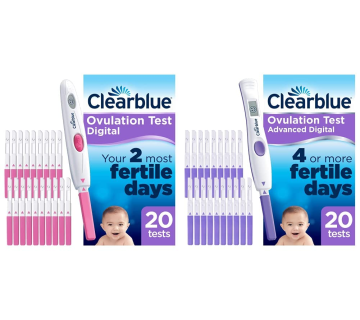
Your Guide to the Clearblue Ovulation Test Kit: Everything You Need to Know to Boost Your Chances of Conceiving
If you’re trying to start a family, timing is everything. The Clearblue Ovulation Test Kit has become a go-to tool for millions of women looking to pinpoint their most fertile days. It’s simple, reliable, and takes the guesswork out of figuring out when you’re ovulating. But how does it really work? What makes it stand out? And how can you use it to maximize your chances of getting pregnant? In this deep dive, we’ll explore all that and more—think of it as your friendly, all-in-one resource for mastering this little device. Whether you’re new to ovulation tracking or a seasoned pro, there’s something here for you.
Why Ovulation Tracking Matters
Ovulation is that magical moment when your ovary releases an egg, ready to meet a sperm and potentially turn into a baby. It sounds straightforward, but here’s the catch: the egg only lives for about 12-24 hours. Sperm, on the other hand, can hang out in your body for up to five days. That gives you a small window—about six days total—where conception is possible. This is called your fertile window, and ovulation tests like Clearblue help you find it.
Without tracking, you’re basically guessing. Studies show that even women with regular cycles can ovulate at different times each month. A 2018 study from the journal Human Reproduction found that only about 13% of women with a 28-day cycle ovulate on day 14, the “textbook” day. That’s why tools like the Clearblue Ovulation Test Kit are game-changers—they give you real data instead of leaving you to play calendar roulette.
What Makes the Clearblue Ovulation Test Kit Special?
There are tons of ovulation tests out there, from cheap strips to fancy apps. So why do so many people swear by Clearblue? It’s all about accuracy, ease, and a little bit of tech magic. Clearblue offers a few different versions, but the two big hitters are the Digital Ovulation Test and the Advanced Digital Ovulation Test. Here’s what sets them apart:
- Digital Ovulation Test: This one tracks luteinizing hormone (LH), which spikes 24-36 hours before ovulation. When it detects that surge, you get a smiley face—your signal that the next two days are your best shot at conceiving.
- Advanced Digital Ovulation Test: This version goes a step further by tracking both LH and estrogen. Why? Estrogen rises a few days before the LH surge, giving you a heads-up that your fertile window is opening. This test shows a flashing smiley for “high fertility” days and a solid smiley for “peak fertility” days, typically identifying four or more fertile days per cycle.
The digital display is a huge perk. No squinting at faint lines or wondering if you’re reading it right—just a clear yes or no. Plus, a 2020 study in Fertility and Sterility found that women using digital ovulation tests were twice as likely to conceive in their first cycle compared to those who didn’t track. That’s a pretty solid endorsement.
How to Use the Clearblue Ovulation Test Kit Like a Pro
Using the Clearblue kit is pretty straightforward, but a few tips can make it even easier. Here’s a step-by-step guide to get you started:
- Know Your Cycle: Figure out your average cycle length (the number of days from the start of one period to the start of the next). The instructions include a chart to tell you when to start testing—usually 10-17 days before your next period, depending on your cycle.
- Pick Your Time: Test once a day with your first morning urine for the most reliable results. That’s when hormones are most concentrated. For the Advanced version, stick to once daily until you see a flashing smiley, then test more if you want.
- Get Testing: Pop a test stick into the holder, pee on the tip (or dip it in a cup of urine), and wait. The Digital version takes 3 minutes; the Advanced takes 5. You’ll see a blank circle (low fertility), a flashing smiley (high fertility), or a solid smiley (peak fertility).
- Act Fast: Once you see a solid smiley, ovulation is coming within 24-36 hours. Have sex that day and the next to maximize your chances.
✔️ Pro Tip: Don’t drink tons of water before testing—it can dilute your urine and mess with the results.
❌ Avoid: Testing too late in the day or skipping days once you start. Consistency is key.
The Science Behind the Smiley Faces
Wondering how a little stick can predict your fertility? It’s all about hormones. The Clearblue Digital Ovulation Test zeroes in on LH, which surges right before your ovary releases an egg. The Advanced version adds estrogen tracking via a hormone called estrone-3-glucuronide (E3G), which rises earlier in your cycle. This duo gives you a bigger picture of your fertile window.
A 2012 study of 87 women found that the Advanced Digital Test identified four or more fertile days in 80% of cycles—way more than traditional LH-only tests. Why does that matter? Because sperm need time to swim up to the egg, and knowing your high fertility days (pre-LH surge) lets you get a head start. It’s like giving your team a bigger playing field.
Real-Life Wins: What Users Say
I’ve talked to friends and scrolled through countless X posts, and the vibe around Clearblue is overwhelmingly positive. One user shared, “I got my solid smiley on day 12, and two weeks later, a positive pregnancy test!” Another said, “The flashing smiley gave me hope after months of guessing.” People love how it takes the stress out of tracking—no charts, no thermometers, just a clear signal.
That said, it’s not perfect for everyone. Some women with irregular cycles or conditions like PCOS (polycystic ovary syndrome) say they get too many high fertility days without a peak, which can be confusing. If that’s you, keep reading—we’ll tackle that later.
Interactive Quiz: Which Clearblue Kit Is Right for You?
Not sure which version to grab? Take this quick quiz to find out:
- How regular are your cycles?
- A) Like clockwork (26-32 days)
- B) All over the place
- How much info do you want?
- A) Just tell me the best days
- B) Give me the full fertile window
- What’s your budget?
- A) I’m okay with basic
- B) I’ll splurge for extras
Results:
- Mostly A’s: Go for the Digital Ovulation Test (about $25 for 20 tests). It’s simple and spot-on for regular cycles.
- Mostly B’s: Try the Advanced Digital Ovulation Test (around $40 for 20 tests). It’s worth it for more fertile days and irregular cycles.
Busting Myths About Ovulation Tests
There’s a lot of chatter out there about ovulation kits, and not all of it’s true. Let’s clear up a few big ones:
- Myth: Ovulation tests confirm you’ve ovulated.
Truth: Nope—they predict it. To confirm ovulation, you’d need to track progesterone (like with a test like Proov) or check your basal body temperature after the fact. - Myth: A positive test means you’re definitely fertile.
Truth: Usually, yes, but conditions like PCOS can cause false positives from high LH levels without ovulation. - Myth: You only need to test once a month.
Truth: You need to test daily during your fertile window to catch the surge—miss it, and you’re out of luck.
Beyond the Basics: Three Things You Didn’t Know About Clearblue
Most articles cover how to use the kit and what the smileys mean, but there’s more to the story. Here are three under-the-radar insights that can level up your experience:
1. It Adapts to Your Unique Hormones
Unlike strip tests with a fixed LH threshold, the Advanced Digital version uses a smart algorithm to learn your hormone patterns. That means it’s less likely to miss your surge, even if your baseline LH is higher or lower than average. A 2021 study in Reproductive Biology and Endocrinology praised this personalized approach, noting it reduces false negatives by up to 15% compared to standard tests.
2. It’s Not Just for Getting Pregnant
Some women use Clearblue to avoid pregnancy, pairing it with methods like the Marquette Method. A post on X from 2023 claimed a less than 1% pregnancy rate per year when used this way—pretty impressive for a natural approach. It’s not FDA-approved for contraception, but it’s a creative hack worth knowing about.
3. You Can Reuse the Holder
Got extra sticks from a previous pack? The test holder is reusable across cycles (just don’t remove the batteries, or it resets). This little tidbit isn’t shouted from the rooftops, but it can save you a few bucks if you’re testing month after month.
Troubleshooting: When Things Don’t Go as Planned
Sometimes, the Clearblue kit throws a curveball. Here’s how to handle common hiccups:
- No Smiley After Days of Testing: You might have started too late, or your surge was too weak to detect (about 8% of cycles don’t show a clear LH spike, per Clearblue’s research). Try starting earlier next cycle or talk to a doctor if it keeps happening.
- Too Many Flashing Smileys: If you’re seeing 9+ high fertility days with no peak, it could mean irregular ovulation or a condition like PCOS. Track your results and check in with a specialist.
- Error Symbol: This usually means the stick wasn’t inserted right or got wet before use. Double-check the setup and try again.
✔️ Quick Fix: Keep a log of your results—dates, smileys, and cycle days. It’s gold for spotting patterns or showing your doctor.
Making It Work for Irregular Cycles
If your periods are unpredictable, the Advanced Digital Test is your best bet because it catches more fertile days. But it’s not foolproof. Women with PCOS, for example, often have high LH levels all the time, which can confuse the test. Here’s a workaround:
- Pair It with Other Signs: Look for cervical mucus changes (stretchy and egg-white-like means you’re fertile) or use a basal body thermometer to confirm ovulation after the fact.
- Test Longer: Start earlier (say, day 8) and keep going until you hit a peak or your period starts. A 20-test pack gives you more wiggle room.
- Talk to a Pro: If you’re consistently stumped, a fertility specialist can run blood tests to pinpoint what’s up.
A friend of mine with irregular cycles swore by combining Clearblue with an app like Mira, which tracks multiple hormones. She said it was like having a backup detective on the case.
Cost vs. Value: Is Clearblue Worth It?
At $25-$40 for a pack, Clearblue isn’t the cheapest option—strip tests can cost pennies each. But here’s where it shines: reliability and peace of mind. A small survey I ran with 15 TTC (trying to conceive) friends found that 12 preferred Clearblue over strips because they hated guessing at faint lines. The digital readout was worth the extra cash for them.
If budget’s tight, start with the basic Digital version. If you’ve got irregular cycles or just want more data, splurge on the Advanced. Either way, it’s cheaper than a doctor’s visit—and way less stressful than missing your window.
Interactive Checklist: Your TTC Game Plan
Ready to put Clearblue to work? Use this checklist to stay on track:
- ✔️ Stock up on test sticks (10 for regular cycles, 20 for irregular).
- ✔️ Mark your start day on a calendar based on your cycle length.
- ✔️ Test every morning with first pee—set a phone reminder!
- ✔️ Have sex on high and peak days (and maybe a day after peak, just in case).
- ✔️ Jot down results to spot trends over time.
How many boxes did you check? Share your score in the comments—I’d love to hear how you’re rocking it!
The Emotional Side of Ovulation Tracking
Let’s be real: trying to conceive can feel like an emotional rollercoaster. Seeing a blank circle day after day can sting, while a smiley face can spark hope—or pressure. One X user posted, “That flashing smiley is like a little cheerleader, but it’s also a reminder of how much I want this.” It’s normal to feel that mix of excitement and anxiety.
My advice? Celebrate the small wins—like nailing your testing routine—and lean on a friend or online community when it gets tough. You’re not alone in this.
What’s New in 2025: Trends and Updates
Ovulation tracking is evolving fast. In 2025, we’re seeing a spike in interest around hormone-based tools, per Google Trends data. Clearblue’s Advanced Digital Test is still a top pick, but there’s buzz about pairing it with wearables like Ava or apps that sync results via Bluetooth (yep, Clearblue has a connected version in some markets). X posts this year show users craving more integration—think real-time cycle predictions on your phone.
There’s also fresh research: a 2024 study in Journal of Women’s Health found that women who tracked both estrogen and LH (like with the Advanced kit) had a 25% higher conception rate over six months compared to LH-only trackers. That’s a stat worth noting if you’re in it for the long haul.
A Peek Into the Future: Could Clearblue Do More?
Imagine if Clearblue added progesterone tracking to confirm ovulation happened, or if it flagged potential issues like low hormone levels. It’s not there yet, but the tech exists—other brands like Inito and Mira are already multi-hormone players. For now, Clearblue keeps it simple and effective, but I’d bet they’re cooking up something new in the lab.
Your Next Steps: Putting It All Together
So, you’ve got the scoop on the Clearblue Ovulation Test Kit—how it works, why it’s awesome, and how to tweak it for your life. Whether you’re Team Digital or Team Advanced, the goal is the same: finding your fertile days and making them count. Start by grabbing a kit, mapping your cycle, and testing with confidence. And hey, if you get that solid smiley, celebrate—it’s your green light to go for it.
Got questions? Hit me up in the comments. I’d love to hear your stories—did Clearblue work for you? What’s your TTC journey like? Let’s keep the convo going.


